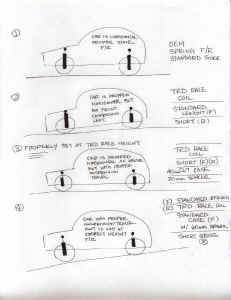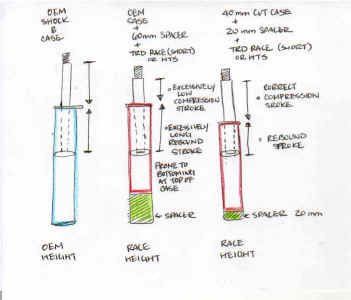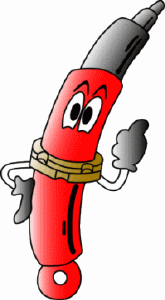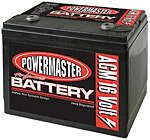Moto-P's Addendum...
WHY DO WE HAVE TO DO THIS? ITS A PAIN!!??
The following is to address the common question of "why" we need to cut (shorten) the strut case for using TRD short stroke. For those who understand it, you can skip this section and get to work...
The strut case on a McPherson strut assembly like the system used on the front of the AE86 (and most other Corollas) are designed operate at a certain vehicle suspension height. Therefore the shock stroke range, compression and rebound, is optimized to the use of standard OEM height strut. The normal stroke range of the AE86 is 186 mm. Now, by using the TRD short stroke "race" strut, the overall suspension travel is reduced to 165 mm, a reduction of 21mm. Add to this the height change by using the short race springs is approximately 30 to 60 mm, depending on your preferred height adjustment of the coil over unit. By installing this in a standard length case will result in a optimum stoke range be vastly out of position. Moreover, the strut case will hit the top mount and prevent the full stroke from occurring, and the front suspension will be left with virtually no stroke on the compression side.
Reason having been explained TRD's decision was to make the strut cartridge 20mm shorter than necessary to provide transferability to other models such as KP61 and AE92. This design translates to the TRD short stroke unit being 62 mm shorter than comparable OEM strut cartridge. (This may vary by model and other comparable shocks such as the Tokico HTS, which are 60 mm shorter) In any case, we must do out subtraction here... So to put a TRD short stroke cartridge into a 40 mm cut strut case, we must also use a spacer at the bottom of the cartridge to place the shock into the optimum stroke location, and in this case the spacer would be 62 mm - 40mm = 22mm, or 22 mm of spacer must be provided to lock the cartridge into correct location.
By careful calculations, you will provide the designed outcome for the TRD short stroke shocks which are in balance with the rear short stroke spring/ shock combination. The rear system is not a height adjustable design, so front strut assembly must be matched to compensate...and this is where the coil-over conversion becomes handy in taking up slight construction error and to fine tune the fore-aft distribution of weight and overall height.
Finally, I'd like to add that fact that.... the suspension in any automobile is a critical part that supports the car and is holding the tire in place. As you can imagine, it is VERY dangerous to have these parts fail, even when the car is stationary... So please use HUGE caution when working with these items and during the design process. Its not a bad idea to go to a junk yard to buy spare set of parts just to practice on, or even to use as spares if there are any mistakes or faults in the final project. Its much more comforting and easy to do so, rather than hunting around desperately for parts in a hurry.
OK, and last item here is a few drawing I had done for some BBS questions in the past...please ignore the fact that the drawing is rather crude, it's for guiding you with pictures to get a rough mental picture of purpose and concept of making the conversion...of course the pictures are not to scale so don't be alarmed if your strut case does not look this way... No, the cartridge is not warped and do not have eyes...(^^)
(Click Photo to enlarge)
Now here's the last advice,
Since you will be taking your suspension apart down to the last nut, I do suggest that you get all your other modifications ready to install at this time. For example the following things can be added as well to make life easier, so as not to repeat the disassembly...
this conversion is for Toyota ae86 setup front suspension and fits some other vehicle with old model Toyota.










